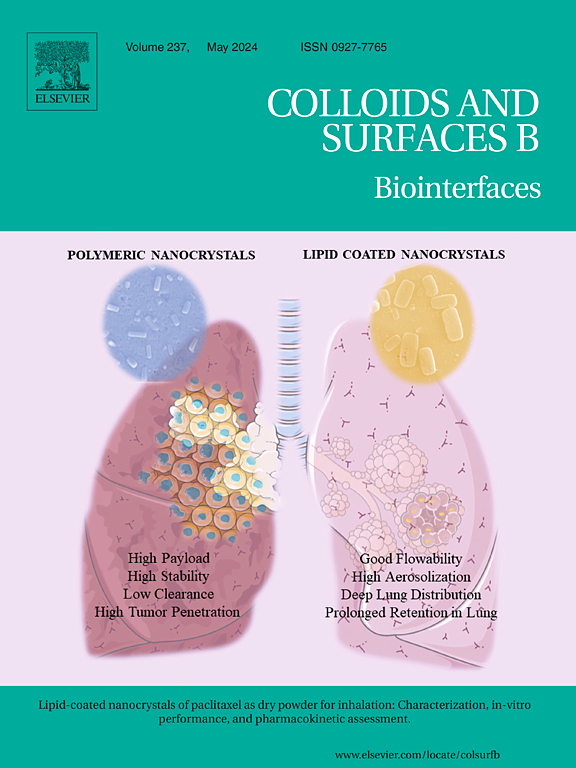Free-standing, flexible and conformable bilayered polymeric nanomembranes modified with gold nanomaterials as electronic skin sensors
IF 5.6
2区 医学
Q1 BIOPHYSICS
引用次数: 0
Abstract
Skin is a barrier that protects us against physical, chemical and biological agents. However, any damage to the skin can disrupt this barrier and therefore compromise its function leading to sometimes catastrophic consequences like sepsis. Thus, methods to detect early signs of infection are necessary. In this work, we have developed a straightforward method for producing 2D nanomembranes with regularly spaced 1D metallic nanostructures integrating sensing capabilities to pH and NADH (nicotinamide adenine dinucleotide), which are critical analytes revealing infection. To achieve this, we have successfully fabricated a bilayered nanomembrane combining a pH-responsive polyaniline (PANI) layer and a nanoperforated poly(lactic acid) (PLA) layer containing gold nanowires (Au NWs) as NADH sensing element. SEM, FTIR, Raman and AFM techniques revealed the formation of the bilayered PANI/PLA nanomembrane and the successful incorporation of the Au NWs inside the nanoperforations. The resulting bilayered nanomembrane showed significant flexibility and conformability onto different substrates due to the softness of the polymers and the ultrathin thickness with stiffness values similar to human skin. These nanomembranes also exhibited remarkable electrochemical sensing performance towards pH and NADH detection. Thus, the nanomembrane displayed linearity with good sensitivity (47 mV pH−1) in the critical pH range 4–10 and fast response time (10 s). On the other hand, PANI/PLA-Au nanomembranes also allowed the quantitative sensing of NADH with a limit of detection of 0.39 mM and a sensitivity of 1 µA cm−2 mM−1 in the concentration range 0–5 mM.
用金纳米材料修饰的独立、柔性和适形的双层聚合物纳米膜作为电子皮肤传感器
皮肤是一道屏障,保护我们免受物理、化学和生物制剂的侵害。然而,对皮肤的任何损伤都会破坏这一屏障,从而损害其功能,有时会导致脓毒症等灾难性后果。因此,检测感染早期迹象的方法是必要的。在这项工作中,我们开发了一种直接的方法来生产具有规则间隔的一维金属纳米结构的二维纳米膜,集成了pH和NADH(烟酰胺腺嘌呤二核苷酸)的传感能力,这是揭示感染的关键分析物。为了实现这一目标,我们成功地制备了一种双层纳米膜,该膜结合了ph响应聚苯胺(PANI)层和含有金纳米线(Au NWs)作为NADH传感元件的纳米穿孔聚乳酸(PLA)层。SEM, FTIR, Raman和AFM技术揭示了双层聚苯胺/聚乳酸纳米膜的形成以及Au NWs在纳米操作中的成功结合。由于聚合物的柔软性和超薄的厚度,所得到的双层纳米膜在不同的基底上表现出显著的柔韧性和一致性,其刚度值与人体皮肤相似。这些纳米膜对pH和NADH的检测也表现出了显著的电化学传感性能。因此,纳米膜在4-10的临界pH范围内具有良好的线性特性(47 mV pH−1)和快速的响应时间(10 s)。另一方面,PANI/PLA-Au纳米膜也可以定量检测NADH,检测限为0.39 mM,灵敏度为1 µa cm−2 mM−1,浓度范围为0-5 mM。
本文章由计算机程序翻译,如有差异,请以英文原文为准。
求助全文
约1分钟内获得全文
求助全文
来源期刊

Colloids and Surfaces B: Biointerfaces
生物-材料科学:生物材料
CiteScore
11.10
自引率
3.40%
发文量
730
审稿时长
42 days
期刊介绍:
Colloids and Surfaces B: Biointerfaces is an international journal devoted to fundamental and applied research on colloid and interfacial phenomena in relation to systems of biological origin, having particular relevance to the medical, pharmaceutical, biotechnological, food and cosmetic fields.
Submissions that: (1) deal solely with biological phenomena and do not describe the physico-chemical or colloid-chemical background and/or mechanism of the phenomena, and (2) deal solely with colloid/interfacial phenomena and do not have appropriate biological content or relevance, are outside the scope of the journal and will not be considered for publication.
The journal publishes regular research papers, reviews, short communications and invited perspective articles, called BioInterface Perspectives. The BioInterface Perspective provide researchers the opportunity to review their own work, as well as provide insight into the work of others that inspired and influenced the author. Regular articles should have a maximum total length of 6,000 words. In addition, a (combined) maximum of 8 normal-sized figures and/or tables is allowed (so for instance 3 tables and 5 figures). For multiple-panel figures each set of two panels equates to one figure. Short communications should not exceed half of the above. It is required to give on the article cover page a short statistical summary of the article listing the total number of words and tables/figures.
 求助内容:
求助内容: 应助结果提醒方式:
应助结果提醒方式:


